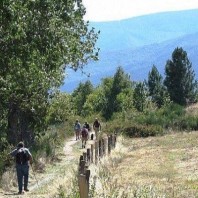The Saint-Giles Way
The Saint-Giles Way is the historical route that links Paris to Lower Languedoc. It links Le Puy-en-Velay to Saint-Gilles-du-Gard, which in the Middle Ages was a Mediterranean sea port. The much shorter ‘Regordane’, which is the term now used by the tourism authorities to refer tho the trail, ran from Luc Castle to Alès, the gateway to The Cevennes.
While the name The Saint-Giles Way [or Chemin de Saint-Gilles] needs no justification, the jury is still out as to the true origins of the name ‘La Regordane’; and whilst some point to the existence of a road of the same name in Jerusalem, the most likely origin is that it took its name from the ancient Province through which it passes – la Regordana. This Province corresponded approximately to the triangular area linking the towns of Alés, Pradelles and l’Argentière.
Whilst the route followed by The Saint-Giles Way probably dates back to the dawn of man (the course follows a natural North-South geological fault-line through a chain of mountains in eastern Cevennes), its importance certainly grew from the year 843 onwards, when it became the most easterly route of a nascent Gaul. It was during this century that the most important staging post along its route, Portes, with its imposing castle, chose Saint Gilles as its patron saint in honour of a miracle that Aegidius supposedly performed there. Pilgrimages to his tomb at St Gilles cathedral are known to have commenced before 1000 AD.
Some writers refer to The Saint-Giles Way or The Regordane as the fourth-most-important pilgrimage of Christendom, such was the prominance of the route during the early Middle Ages. undoubtedly bolstered by its strategic position as a strategic ‘link trail’ for the St Jacques de Compostella [Arles Route], the Holy Land [to where boats embarked] and Rome.
During the Gallo-Romaan era, some referred to The Saint-Giles Way as ‘La Voie des Arvernes,’ linking the strategic cities of Gergovie (Clermont-Ferrand) and Nemausus (Nimes). The XII au XIII centuries saw a growth in the importance of towns, and The Regordane was paved and bridges constructed as the volume of traffic augmented. Responsibility for security lay with ‘Les Seigneurs’ and their castles-cum-toll gates spaced at regular intervals along the route. Safe passage from one staging post to the next was thus assured at a price for those using chariots or mules to carry people and goods along the North-South axis.
The Treaty of 1308 pushed the Kingdom’s frontiers to The Rhone, signaling the end of The Regordane’s ‘Golden Age,’ as the natural advantages of that Valley made it the first choice for most travellers and trade. Climate change in XIV century caused increased levels of humidity. This created the conditions for the birth of The Plague and compounded the lack of investment in the trail’s upkeep, resulting in its gradual decline. The Hundred Years War contributed to its abandonment; and with the continued Eastward spread of the Empire, and the annexation of Marseille, The Rhone Valley’s dominance as the main North/South corridor became insurmountable.
Early industrialism in the ‘Alèsian Basin’ led to a rebirth of interest in this alternative route to the Capital and its markets, with investments made in both macadamized surfaces and The Cévenol railroad. Both follow the same natural fault-lines to Clermont-Ferrand and beyond and were used to transport coal, iron and steel, wine, salt and silk.
The Saint-Giles Way has had some illustrious travellers along its course over its long history; Kings, including Robert le Pieux in 1031 and St Louis in 1254, who departed from Aigues-Mortes en route to the Crusades, with the decline of St Gilles as a port; the Archbishop of Rouen in mid XIII century on pilgrimage to St Gilles; Simon de Montfort en route to crushing the Cathar Albigeois after the killing of the Pope’s emissary at St Gilles; and Louis XIV’s emissaries sent to survey the state of the trail with a view to dispatching troops to crush the Camisards in The Cevennes some 500 years later.
‘The Best of Regordane’ traces the path that Pilgrims, Romans, traders and armies would have followed en route to St Gilles and beyond. It is a France hiking tour designed steadfastly to avoid the temptation to take you along paths that bear no resemblance to The Regordane, but are instead located along existing ‘GR’ routes, or that offer the chance to visit places of interest to tourists. It is meant to be an authentic experience for those who enjoy heritage and historical hiking in France.
We make no apologies for the fact that, following a natural geological fault, some of the route is now tarmacced. That’s progress and that’s life: horses were more powerful than oxen, and it was more efficient to build roads on which they could trot. In a few places the trail has disappeared altogether, and so you follow the next best alternative, as close as possible to the original path.
The Saint-Giles Way is arguably our most authentic walking holiday in France, and‘The Best of Regordane’ takes you along as much as possible of the real route as experienced by travellers trekking France since time immemorial. You walk high volcanic plateau, the schist slopes of the Céze Valley and down into the dry, stony and flatter surfaces of the Garrigues; through medieval villages and linear settlements, whilst admiring their architecture, vestiges and learning about their history.
© The Enlightened Traveller 2021
Further Reading…- ‘The Best of Regordane’ walking tour.
- An account of Walking the Regordane Way.
- Walking in Languedoc.
Click to visit The French Hiker’s Guide to Holidaying in the Hexagon and France self-guided walking, trips, trails, places & themes.


